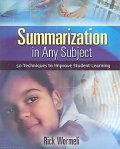Helping Students Process Information

An excellent resource for more information on summarizing
Last week we explored “chunking” or presenting new information in small, digestible bites followed by summarization strategies. This week I challenge you to examine how you are scaffolding and providing time for students to interact with your content. Whereas chunking involves the size of the bites for the new content, scaffolding involves the content of the bites and their logical order. For example, if you were teaching your students a strategy for how to edit an essay for overall organizational logic, you might organize the steps into three chunks. The first chunk would be comprised of the steps that deal with determining whether the composition has good transitions from paragraph to paragraph. The second chunk would involve steps that address whether the major sections of the essay (beginning, middle, and end) logically flow into one another. The third chunk would be steps to determine if the essay as a whole sends a unified message. In other words, each of the chunks sets up the next chunk.
Scaffolding is a form of differentiation that helps meet the needs of all learners. In the video clip below, the teacher provides scaffolding exercises on the concept of “loyalty” within Julius Caesar. Students are asked to connect content to their personal experiences, use their mathematical skills, and justify and evaluate the content of the text. Students are expected to interact with the content and one another to gain a greater understanding of the curriculum. Retention of lesson concepts improves when students have the opportunity to use the information they have learned in a meaningful way.
Interacting refers to how students process the information in each chunk. An easy way to facilitate processing is to organize the class into small groups and ask each group to summarize the content in the chunk, identify anything that was confusing, try to clear up the confusion, and predict what information might be found in the next chunk. You are already familiar with many formative assessment strategies to facilitate this process. A few I have seen you use include:
- Plus, Minus, Intriguing

- Brain Dump
- Quick Writes
- Graffiti Write
- GIST
 When you have explored one level of the scaffold and are ready to move on, use formative assessment strategies to determine the level of mastery of your students. Concentrate on having as many students as possible respond. You may want to have students use Response Cards to agree, disagree, or add to a response. Another technique you may want to try is to use one of our voting technologies. The “clickers” will allow students to electronically cast their votes regarding the answer to a question. Student responses are immediately displayed on a pie chart or a bar graph, enabling you and your students to discuss the different perceptions and/or misconceptions regarding the questions. If technology is not available when you want to use it, why not use small white boards to get students actively engaged and allow you to assess your students without giving a grade.
When you have explored one level of the scaffold and are ready to move on, use formative assessment strategies to determine the level of mastery of your students. Concentrate on having as many students as possible respond. You may want to have students use Response Cards to agree, disagree, or add to a response. Another technique you may want to try is to use one of our voting technologies. The “clickers” will allow students to electronically cast their votes regarding the answer to a question. Student responses are immediately displayed on a pie chart or a bar graph, enabling you and your students to discuss the different perceptions and/or misconceptions regarding the questions. If technology is not available when you want to use it, why not use small white boards to get students actively engaged and allow you to assess your students without giving a grade.
Once you have determined student understanding, then you will know whether to reteach or accelerate before moving to the next chunk.
References
Marzano, R. J. (2007). The Art and Science of Teaching: A Comprehensive Framework for Effective Instruction. Alexandria, VA: Association For Supervision & Curriculum Development.
Wormeli, R. (2004). Summarization In Any Subject: 50 Techniques To Improve Student Learning. Alexandria, VA: Association For Supervision & Curriculum Development.